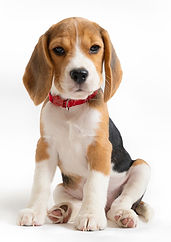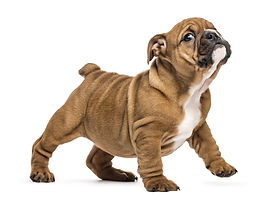The Educated Dog
Training and Behavior Modification
info@educateddogtraining.com (917) 428-1516
Set Your Puppy up for Success
Puppies are wonderful, sweet, playful, and a LOT of work! But all the time you put in during these first few months will pay off with an adult dog who is confident, well-mannered, and safe with other dogs, kids, and people. Below highlights the most important steps to take.
I. The Urgency of Socialization
Don't wait until your puppy has his 2nd round of vaccines!
Vets often advise to keep your puppy inside or highly restricted until he receives his 2nd round of shots, generally around 14 or so weeks. This is good advise if all we care about is preventing infectious diseases. However, it is widely reported that about 80% of dogs are relinquished for behavioral problems, this too is a risk - a huge risk. And even if the dog is not relinquished, living with a fearful, reactive or aggressive dog causes hardship for both the dog and his guardians.
What does this have to do with socialization?
Puppies go through what is called the critical period between 3-14 weeks. This is the time where the puppy learns what is safe in his world - this includes other dogs and animals, humans of all sizes and forms, all types of vehicles, thunder storms, marble floors, and the list goes on. During this time the puppy's brain is like a sponge and what it learns in this specific period stays with him for life. This does not mean that a dog cannot overcome fears or aggressions after 14 weeks, but it does mean it makes it significantly more difficult.
How do I properly socialize my dog?
Taking your dog with you to various places, introducing them to other dogs, people and experiences all play an important role in socialization, but in itself is not enough. Below are a few tips to help you with the process.

AVSAB Position Statement
See of the American Veterinary Society of Animal Behavior Position Statement regarding the importance of early socialization here. All their position statements are well worth reading.
See the PDF checklist below to help you properly socialize your puppy.
-
Keep all introductions with new experiences neutral to positive - this means that you should remove your puppy from the situation if he exhibits fear or even mild signs of stress (see Deep Dive for references on how to read your puppy's body language). You can then reintroduce your puppy to the situation in a more gentle manner.
-
Enroll your puppy in puppy play groups and socialization classes (ensure they limit age to around 14 weeks or so).
-
Use a check list, such as the one I provide on this page, and check off as many of the items as possible.
-
Train using only positive reinforcement- you want your puppy to love you and love learning!
II. Puppy Proofing

Keep your puppy safe and happy at home!
-
Keep anything you don't want eaten, chewed on, or peed on out of reach! This includes furniture, rugs, medicines, plants (many are toxic to dogs), and electrical cords - just to name a few.
-
Crates, gates and playpens are the easiest way to keep him safe while unsupervised.
-
Make this area welcoming! Hide treats, have fresh water, bedding, and plenty of toys - including chew toys, puzzles, snuffle mats, balls, and tug toys. This keeps him happy and busy - and presents him suitable alternatives to chewing your table legs! It is important to never use this area as punishment.
Keep your puppy safe and happy on walks!
There is no one size fits all solution, but in general, the following come highly recommended.
-
Use a six foot, non-retractible nylon flat leash, under 1" in width, for everyday walks - this gives you the most control, and your dog ample space to sniff around and greet others.
-
Front-clip no-pull harnesses, such as the Balance Harness by Blue-9 or similar designs, offer gentle and effective ways to discourage pulling. Back-clip harnesses often serve to encourage pulling.
-
Prong, choke, electric (e-) collars, or 'bark' collars are NEVER recommended - pain or discomfort have no place in learning.
-
Collars are generally necessary for identification and licensure purposes, and some embed GPS devices, great for anyone who plans to take their dog off-leash or use walking or boarding services. As a bonus, GPS tracks his routes and number of steps! There are a variety of brands to choose from including Fi and Whistle.
III. Crate Training
The Crate
Crates are very useful for potty training, but outside of specific needs (medical, travel), dogs should not be confined in crates, or in general. Excessive confinement has been linked to a number of behavior problems including compulsive behavior disorders , frustration, boredom, and depression. The literature on separation anxiety in dogs strongly suggests that confinement worsens separation anxiety (see Deep Dive).
The crate should be large enough for your puppy to stretch out, turn around, and be comfortable. Some crates come with dividers to adjust the length as the puppy grows. As long as the puppy is not soiling the crate, there is no need to make it smaller. Always remove collars and harnesses before he goes into the crate - they can pose serious injuries such as choking.
Safe and Happy Place
Your dog should see his crate or gated area as a safe, fun, and relaxing place. This means you should never put your dog in the crate as punishment, or forcefully. Ensure the area includes fresh water, comfortable bedding, and plenty of toys to keep him busy and happy. Place the crate in a comfortable location close to you - do not isolate him.
Training
Never pick up your puppy and put him in the crate, have him go in willingly. At first, this may require treats to lure him in: but like all behaviors, can be taught through shaping or targeting and following the training process. Although the training process applies to both puppies and dogs, keep in mind that puppies generally have shorter attention spans, so you will want to keep sessions shorter.
In order to train your puppy to be comfortable in his crate for longer periods of time, start with very short durations (seconds or minutes) and then very gradually increase the time. If he starts to bark, yelp, scratch or show any other stress signals, shorten the time in the crate. You want the time in the crate to be associated with relaxation, not anxiety or stress.
Remember, as is true for all training, your puppy determines the pace of progression, not you.

Love Your Crate!
Crates are great for medical reasons, travel, potty training, and other necessities. Otherwise, your dog should choose when and for how long he goes into his crate. Yes, he loves his crate, but he also loves his freedom, exercise, and mental stimulation,.
It is therefore recommended that limit the time you keep your dog in the crate to under 4 hours. Locking him in his crate all day is inhumane and can lead to behavior problems such as compulsive behavior disorders, depression, and frustration.
IV. Feeding

Staying Healthy
Determine your dog's ideal weight, then come up with a plan to get him there and keep him there. Weigh him monthly, and count calories - be sure to count all meals, treats, and training reinforcements.
The Animal Medical Center of NY is a great resource - see link.
Feeding Tips
It is important to consult your veterinarian or nutritionist with any concerns you have regarding weight, allergies, or nutritional requirements. Below are some tips:
-
Have fresh water available at all times.
-
Clean the water and food bowls between meals. This may seem obvious, but it is easy to fall in the habit of rinsing the bowls out, rather than disinfecting with dish soap and water.
-
Choose wisely.
-
Ensure the food is a formula for a puppy and appropriate for his size.
-
Check the ingredients. The first ingredient should be a high quality protein, and avoid food with 'by products' listed as an ingredient,
-
Check that the food is labeled "Complete and Balanced" on the packaging - see FDA requirements for details.
-
Dogs like variety, you may want to consider buying a few different recipes of the same brand, or mix in 'toppers' or other healthy additions.
-
-
Stick to a feeding schedule - generally three times a day for puppies, and twice for dogs.
-
Measure, don't guess on portion size.
-
Do not leave food in the bowl between meals, pick up what he does not eat. This will help keeping him on a schedule, and helps with training - keeps him food motivated.
-
Store the food properly, both to prevent spoilage and him getting into it.
-
Know what foods are toxic to dogs - see the ASPCA site for details.
-
Home made dog food can be a great choice, but not without the help of your veterinarian to ensure each meal is complete and balanced, as discussed above.
-
Yes, carrots are good for your pup ;-)
V. Potty Training
The Principles
Housetraining your puppy is very easy in concept, but takes discipline and time commitment to be successful. As explained in Problem Behaviors, the first step in stopping unwanted behavior is to stop it! That means finding ways to prevent accidents from happening as much as possible. The next step in stopping unwanted behavior is to reward what you do want, eliminating outside! It is that simple. Here are some guidelines.
The Rules
-
The most important rule is to make sure that your puppy is either with you outdoors, supervised indoors, or in his puppy- proofed area when alone. This is the key to success.
-
Between 8-14 weeks old, take you puppy out every hour - and more if they have been active. Always take your puppy out immediately in the morning, and right before bedtime.
-
Feed on a regular schedule, pick up food between meals.
-
Reward your dog immediately after eliminating outside.
-
Learn the signs of him needing to go out, such as after play, awaking, pacing, or sniffing.
-
Clean up accidents with enzymatic neutralizers, not household products - in order to effectively get rid of the scent.
-
Dogs tend to eliminate on carpets and soft flooring, best to avoid or remove these items if possible.
-
Over time, gradually, the puppy will be able to gain more freedom around your home.
-
Keep track of accidents, this will help you adjust his schedule to prevent accidents.
-
Mistakes happen. Be patient and forgiving, and remember, he is a just a puppy, and still learning.

The Problem with Punishment
The situation: You notice an accident on your floor, so you grab your puppy, stick his nose in it, and yell 'No!'. He gets scared, tail down, and walks away.
What he learned: That the combination of you and his pee or poop is scary.
What he did not learn: That the act of eliminating indoors was wrong.